This blog-post summarize the IoT (Internet of Things) in 5G. IoT is a technology that connects things to networks that have been standardized by 3GPP since before 4G LTE.
One of the 5G concepts is mMTC (Massive Machine Type Communications). It is considered that not only smartphones but also a large number of “things” will be wirelessly connected to mobile network. These “things” are assumed to be home appliances, factory machinery, office equipment, and sensors such as cameras.
IoT will be more technologically advanced and widely used with 5G. In particular, IoT in the industrial field is called Industrial IoT (IIoT). Industrial IoT is IoT aimed at optimizing manufacturing and improving productivity in the industrial field.
Difference between IoT(Internet of Things) and M2M(Machine to Machine)
What is IoT(Internet of Things)?
IoT is a technology that uses wireless communication standardized by 3GPP such as 5G NR and 4G LTE to connect things to Internet. Also, IoT consists of “sensors”, “servers” and “gateways”, which are connected by the Internet. Check the state of things with sensors and send that information to the server via the Internet.
In IoT, data is aggregated and analyzed on servers. Therefore, IoT is expected to utilize Big-Data. In addition, there is a security problem because it is connected to the Internet.
IoT can be broadly classified into two types. These are “Sensor, Smart Meter IoT (LPWA: Low Power Wide-Area)“ and “Mission Critical IoT“. Furthermore, sensor and smart meter IoT can be classified into “Cellular LPWA” and “Non-Cellular LPWA”. The classification of IoT is shown in the figure below.
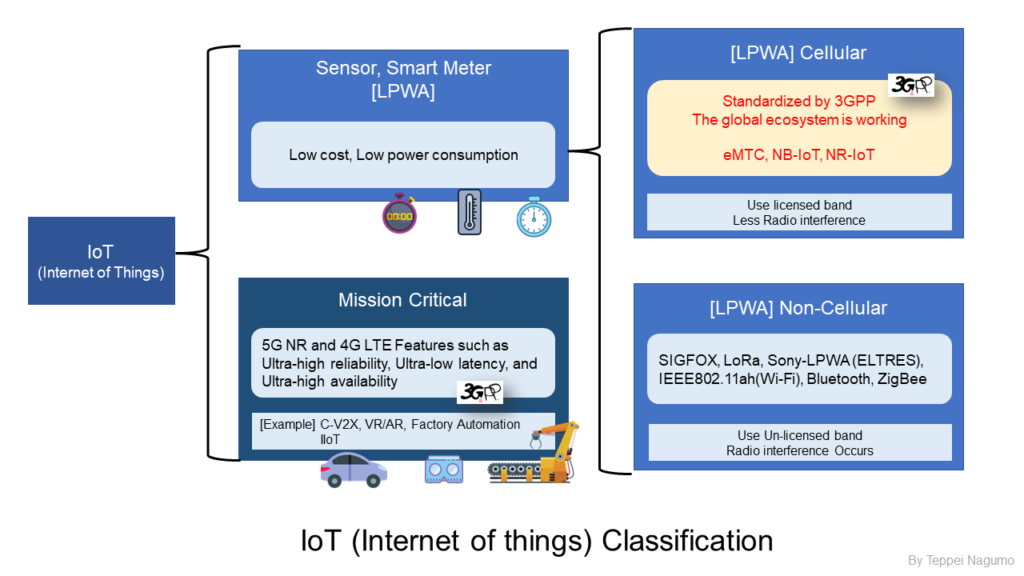
What is M2M(Machine to Machine)?
M2M (Machine to Machine) is a technology in which objects communicate with each other and automatically exchange data and control devices. M2M is a technology positioned to be included in IoT.
M2M is based on the idea of Ubiquitous Computing and is defined separately from IoT. As a term corresponding to M2M, M2H (Machine to Human) is a technology that communicates between things and people.
Expansion of 5G/4G IoT market and NB-IOT/eMTC IoT market
Various industries are using 5G/4G Network to conduct IoT business. It is expected that the number of connected subscribers will increase rapidly in the future. The IoT market is expanding, and related businesses are expanding rapidly.
The figure below is referenced from ERICSSON’s public document (Ericsson Mobility Report, 2022). The number of terminals for 5G/4G broadband and mission-critical IOT and cellular IoT LPWA (NB-IOT/eMTC) is expected to increase rapidly. The cellular IoT market is expanding significantly.
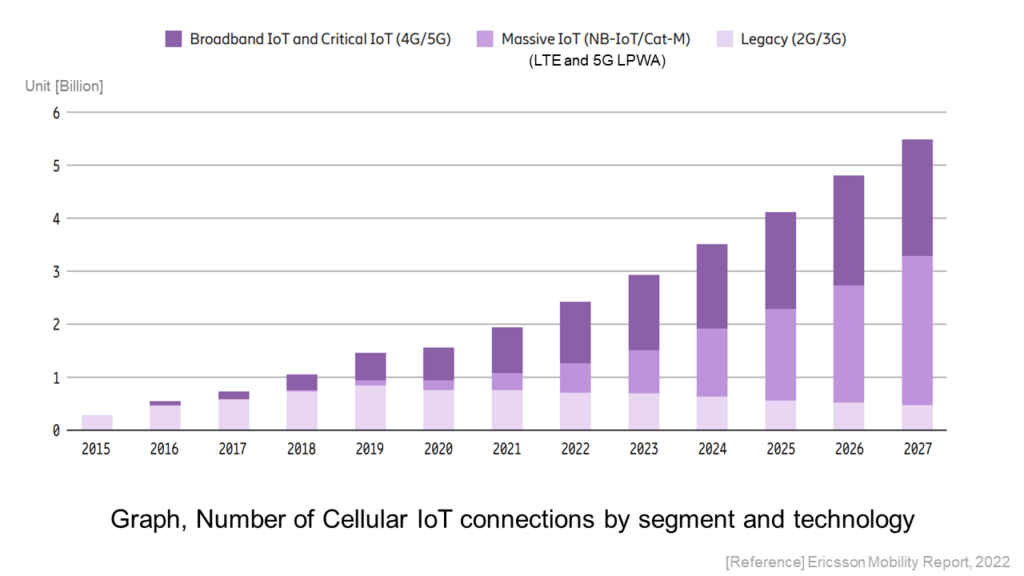
Ericsson Mobility Report, [Ericsson official site, 2022 report]
Types of IoT (Internet of Things) and their classification
IoT can be broadly classified into “LPWA (Sensor, Smart Meter IoT)” and “Mission Critical IoT“.
Cellular-related IoT is being standardized by 3GPP. The figure below shows the flow of standardization at 3GPP for each cellular IoT technology.
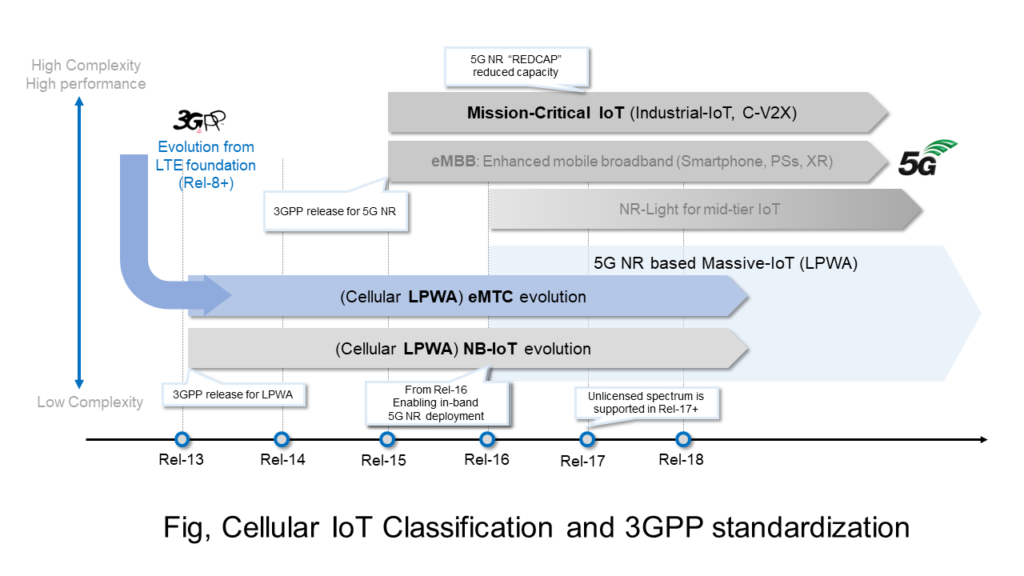
The above figure refers to the following materials published by Qualcomm.
Qualcomm, Expanding 5G in Industrial IoT, [Qualcomm official site, PDF file link]
For more information on 3GPP (Third Generation Partnership Project), the international standardization body for mobile communications such as 5G/4G/3G, see the blog post below.
Sensors, Smart Meter IoT (LPWA: Low Power Wide Area)
Sensor and smart meter-based IoT is called LPWA (Low Power Wide Area-network), and wireless communication with mobile networks is performed with less power consumption and fewer wireless resources than smartphone wireless communication (eMBB use case).
Sensor and smart meter IoT are further classified into “Cellular LPWA” standardized by 3GPP and “None-Cellular LPWA“.
Differences between cellular LPWA NB-IoT and eMTC
LPWA IoT has been standardized since Release-8 of the standardization body 3GPP. In consideration of efficiency and new requirements, standardization is being promoted as NB-IoT (Narrow-Band IoT) and eMTC (Enhanced Machine Type Communication). As a wireless communication standard that consumes less power than smartphones, it has been standardized by 3GPP for communication for sensors and smart meters.
This blog post explains the differences between eMTC and NB-IoT, especially in terms of technical specifications. NB-IoT has a narrower communication bandwidth and does not support mobility terminals. It is a low-power IoT communication targeting the smartification of electric meters, gas meters and other fixed meters. The fig below compares the technical specifications of eMTC and NB-IoT.
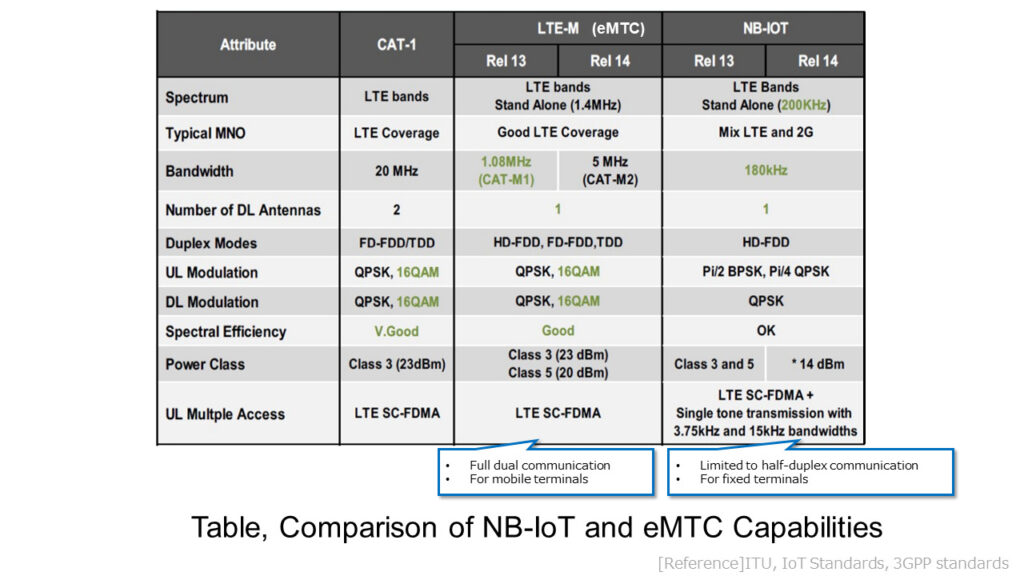
The table above is taken from the following ITU publicly available document.
[Reference] IoT Standards, 3GPP standards, ITU, (PDF file link)
NB-IoT was standardized as CAT M in Release-13 of 3GPP. CAT M is an LTE communication that uses the 200kHz radio band. It is a wireless communication with a very narrow bandwidth. It does not support voice calls or move to terminal (mobility). This is fixed wireless communication where the terminal does not move.
eMTC was standardized as LTE CAT M1 in Release-13 of 3GPP. Supports full-duplex communication. Voice communication is also possible with LTE wireless communication using the 1.08MHz wireless bandwidth. It also supports device mobility.
NB-IoT(LTE CAT NB1 and CAT NB2) and eMVC(LTE CAT M1 and CAT M2) 3GPP standardization and related technologies
NB-IoT (LTE CAT NB1) and eMTC (LTE CAT M1) were standardized in 3GPP Release-13. Since then, efficiency improvements and new requirements have been considered.
The standardization of IoT is progressing even after the commercialization of 5G. Technology that simplifies the circuit of the LPWA IoT device and makes it possible to produce the device at low cost is considered as a requirement.
The figure below summarizes the flow of LPWA NB-IoT and eMTC standardization in 3GPP and the generation of mobile networks.
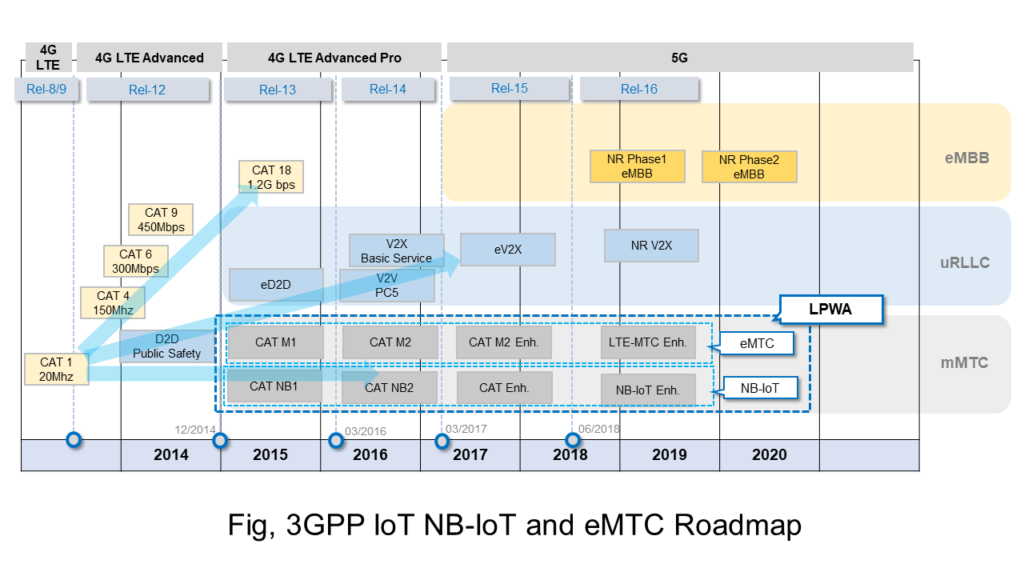
uBOX AGの公開資料(link)を参照しています。
NR-IoT (New Radio IoT) in 5G
Since 3GPP Release-15, IoT using NR (New Radio) wireless communication has been specified as 5G. Standardization is underway to enable wireless communication that uses less power and fewer radio resources.
NR-IoT is New Radio IoT based on 5G wireless communication. The construction and installation of 5G networks is progressing, and the use of wireless communication from 4G LTE to 5G New Radio is expanding. Efficient wireless communication is possible by using 5G New Radio, wireless communication. The battery lasts longer and more terminals (IoT devices) can be connected to the single 5G antenna site.
Mission critical IoT
“Mission Critical” IoT requires Ultra-Reliable and Low Latency (URLLC) communication. Specifically, it refers to automatic driving Vehicle (C-V2X: Cellular-Vehicle to Everything), VR: Virtual Reality / AR: Augmented Reality technology, remote medical device connection, etc.
C-V2X (Cellular Vehicle to Everything), which is communication in the field of autonomous driving, is also being standardized by 3GPP. IoT also includes PC5 (Slide-Link) that supports D2D (Device-to-Device). Please refer to the following blog post regarding IoT cellular communication C-V2X in the automotive industry.
5G IIoT (Industrial IoT) that requires high reliability
IIoT (Industrial IoT) is IoT in the industrial field. IIoT means services and business models that are realized by connecting industrial machines, devices, systems, etc. through the Internet.
It is a technology aimed at improving production efficiency and safety in the manufacturing industry and optimizing logistics and transportation. IIoT is expected to improve the efficiency of the supply chain for procurement of production raw materials, distribution, sales, and delivery to consumers. This is expected to accelerate innovation in the industrial field.
IIoT assumes constant connectivity and requires a high level of wireless connectivity. IIoT is a new IoT technology and is included in Mission-Critical IoT.
Summary
This blog post summarizes IoT in 5G. This blog post has organized the terms related to IoT and their meanings so that you can understand them.
In this blog post, briefly explained the difference between the types of IoT and their technical specifications. In particular, it explained the past trend of IoT standardization in 3GPP and the technical specifications of IoT.
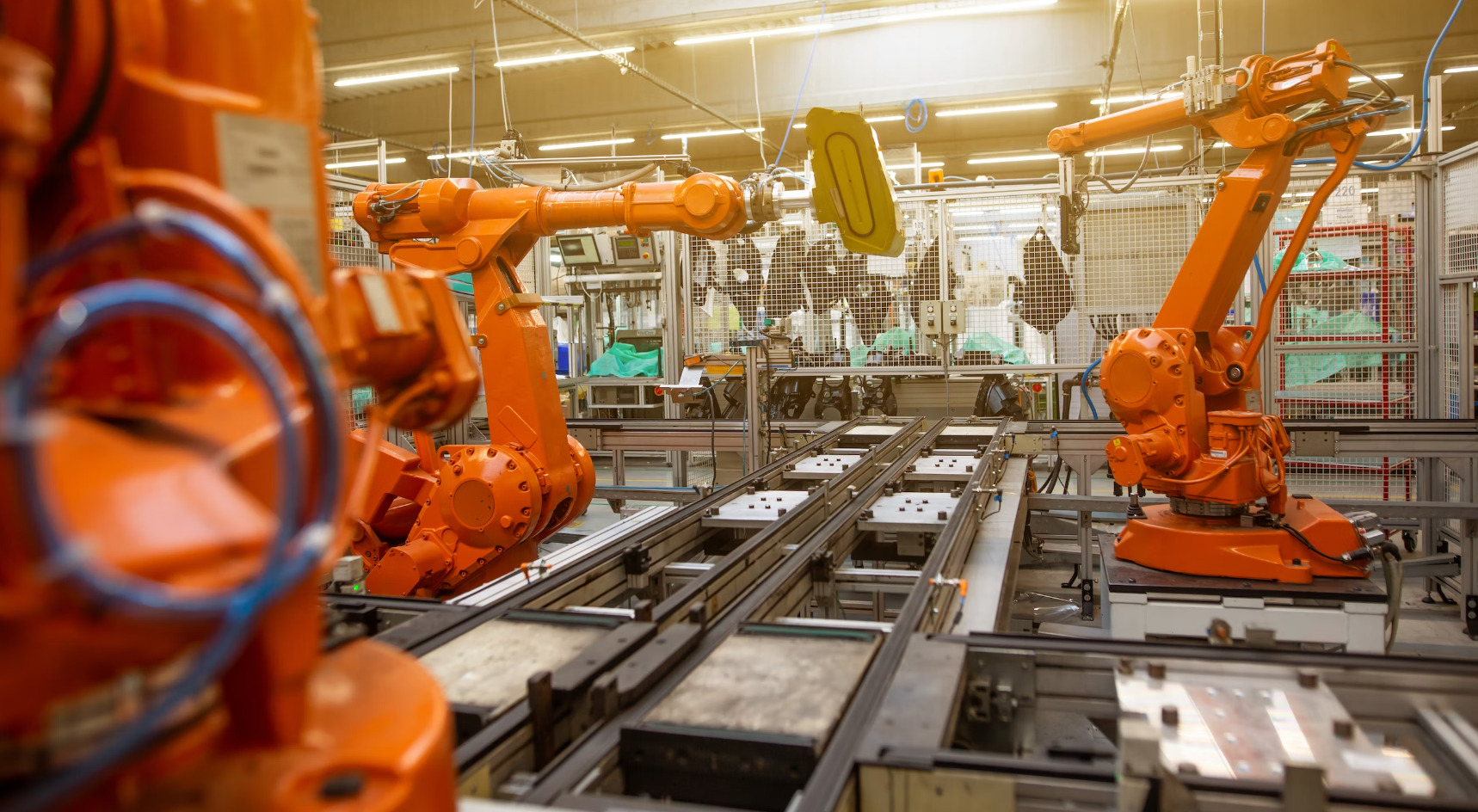




コメント